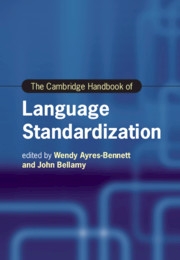Book contents
- The Cambridge Handbook of Language Standardization
- cambridge handbooks in language and linguistics
- The Cambridge Handbook of Language Standardization
- Copyright page
- Contents
- Figures
- Tables
- Contributors
- Introduction
- Part I Revisiting Models and Theories of Language Standardization
- Part II Legitimacy, Authority and the Written Form
- Part III Norms, Literacy and Education
- 14 Language Endangerment and Standardization
- 15 Indigenous Languages, Standardization and Curricular Development
- 16 Polynomic Standards
- 17 Standard Languages and Standardization in the Context of Bilingual Education
- 18 Setting Standards for Language Learning and Assessment in Educational Contexts
- Part IV Beyond the National
- Part V Standardization in Late Modernity
- Name Index
- Subject Index
- References
15 - Indigenous Languages, Standardization and Curricular Development
The Case of the Maāori Language Mathematics Lexicon
from Part III - Norms, Literacy and Education
Published online by Cambridge University Press: 01 July 2021
- The Cambridge Handbook of Language Standardization
- cambridge handbooks in language and linguistics
- The Cambridge Handbook of Language Standardization
- Copyright page
- Contents
- Figures
- Tables
- Contributors
- Introduction
- Part I Revisiting Models and Theories of Language Standardization
- Part II Legitimacy, Authority and the Written Form
- Part III Norms, Literacy and Education
- 14 Language Endangerment and Standardization
- 15 Indigenous Languages, Standardization and Curricular Development
- 16 Polynomic Standards
- 17 Standard Languages and Standardization in the Context of Bilingual Education
- 18 Setting Standards for Language Learning and Assessment in Educational Contexts
- Part IV Beyond the National
- Part V Standardization in Late Modernity
- Name Index
- Subject Index
- References
Summary
As a result of New Zealand’s colonial history, the indigenous Maori language was excluded from schooling (formally) and from a number of other language domains (informally) for over 100 years. By the late 1970s, Maori was considered an endangered language, heading towards extinction. In response, various grassroots Maori communities initiated Maori-medium education, which required, amongst other linguistic challenges, the rapid development of a corpus of terms to enable the teaching of all subjects in the Maori language. Eventually, Maori-medium schooling became state funded, which was accompanied by a requirement by the state agency which controlled education to standardize the corpus of terms for schooling. In this paper, we explore the challenges associated with the (re)development of te reo Maori in the 1980s and 1990s as an educationally standardized indigenous language in relation to one key curriculum area: pangarau (mathematics). This includes analysing the key role of top-down agents and agencies in the standardization of the pangarau lexicon and register. The chapter also examines the influence of the agents’ linguistic ideologies on subsequent corpus development that still determines the codification of terms thirty years later.
Keywords
- Type
- Chapter
- Information
- The Cambridge Handbook of Language Standardization , pp. 421 - 441Publisher: Cambridge University PressPrint publication year: 2021
References
- 1
- Cited by



